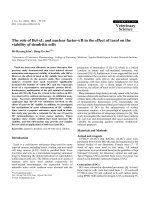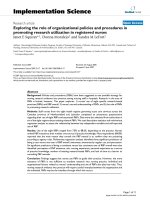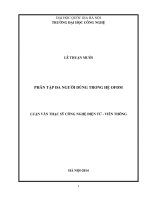(Luận văn thạc sĩ) exploring the role of good leadership and corporate governance practices in improving institutional investment to listed companies in vietnam stock market
Bạn đang xem bản rút gọn của tài liệu. Xem và tải ngay bản đầy đủ của tài liệu tại đây (1.21 MB, 137 trang )
VIETNAM NATIONAL UNIVERSITY,
HANOI SCHOOL OF BUSINESS
NGUYEN THI YEN VY
EXPLORING THE ROLE OF GOOD LEADERSHIP AND
CORPORATE GOVERNANCE PRACTICES IN
IMPROVING INSTITUTIONAL INVESTMENT TO LISTED
COMPANIES IN VIETNAM STOCK MARKET
Major: Business Administration
Code: 60 34 05
MASTER OF BUSINESS ADMINISTRATION THESIS
Supervisors: Dr. Tạ Ngọc Cầu
Hà Nguyên, MBA
Hanoi – 2012
ACKNOWLEDGMENT
I would like to give special thanks to my advisors and teachers, Professor Tạ Ngọc
Cầu, Professor Hà Nguyên and Professor Edward McAlvanahfor all of their
willingness and enthusiasm in guidance and encouragement me through out my
MBA program and the research progress of this dissertation.
To my mother (Kim Ngân) and family, I specially thank for their encouragement,
support and trust during the MBA program.
I also want to show my deep gratitude to Hanoi School of Business for all their
academic support and for administrative assistance since the commencement to the
end of my Regular MBA program.
Last but not least, I wish to specifically acknowledge my ReMBA7 classmates, my
colleagues at Bao Viet Securities Company and counterparts atothersecurities
companies who contributed through their valuable discussions on my chosen topic.
Hanoi, September 2012
Nguyen Thi Yen Vy
i
ABSTRACT
EXPLORING THE ROLE OF GOOD LEADERSHIP AND
CORPORATE GOVERNANCE PRACTICES IN
IMPROVING INSTITUTIONAL INVESTMENT TO LISTED
COMPANIES IN VIETNAM STOCK MARKET
Nguyen Thi Yen Vy
MBA Candidate, 2008 – 2010
School of business
Vietnam National University, Hanoi
Supervisors: Dr. Tạ Ngọc Cầu
Hà Nguyên, MBA
September 2012, 123 pages
The formation of Vietnam stock market in 2000 opened wide door for companies in
raising fund to finance their business activities. On this modern financial market,
institutions have been and should be major players who pump funds and create
market liquidity. However, since 2010, market liquidity has been decreasing and
this is attributed to the lack of “big players” on the market. Therefore, it is high time
to retain current institutional investors and attract new ones to help recover the
slumping market.
One of the main factors to foster that desire is the listed companies‟ excellent
leadership and corporate governance, as they could help companies enhance
investors‟ confidence through mitigating agency problems, creating greater value
for companies and therefore institutional investors in most cases are willing to pay a
good premium for well led and governed companies. This study, accordingly,
explores the relationship between good corporate leadership - governance practices
and the improvement of institutional investment. It also aims to serve as a guide for
ii
those who wish to strengthen leadership and corporate governance practices in their
organizations.
Key findings of the research consist of three parts. Firstly, it determines the
relationship between good leadership - corporate governance practices and the
improvement of institutional investment in Vietnam listed companies. Secondly, it
identifies weak points in the current leadership and corporate governance practices
in Vietnam listed companies. Thirdly, it provides guidance on how to perform good
leadership - corporate governance practices efficiently and effectively to improve
institutional investment.
The study relies on a variety of data collection methods, interviews, observations
and case study method. This technique provided a comprehensive illustration of the
effectiveness and necessity of good leadership and corporate governance practices
in association with successful improvement of institutional investors.
The thesis consists of three chapters:
CHAPTER 1: LITERATURE REVIEW
Chapter 1 showed the correlation between good leadership - corporate governance
practices and the improvement of institutional investment. It also gave an overview
of institutional investors, leadership and corporate governance.
CHAPTER 2: ANALYSIS AND ASSESSMENT ON THE APPLICATION OF
LEADERSHIP-CORPORATE GOVERNANCE PRACTICES IN VIETNAM
LISTED COMPANIES
This chapter provides a snapshot on Vietnam economic outlook and securities
market, makes assessment on leadership and corporate governance in Vietnam and
show three examples of Asia Commercial Bank (ACB), FPT Corporation (FPT) and
Vinamilk (VNM) which have the ability to keep quality institutional ownership over
years.
CHAPTER 3: RECOMMENDATION
iii
Chapter 3 presents both opportunities and threats to the improvement of institutional
investment, then provides recommendation and action plan to identifying and
improving the institutional investment through good leadership and corporate
governance practices.
The author knows that successful application of good leadership and corporate
governance is an art of each company. Nevertheless, the study shows that the theory
and practical experience can be jointed to figure out a reasonable method for most
companies. The most importance is that the companies should well consider their
own conditions and objectives to select what are most appropriate.
iv
TĨM TẮT
TÌM HIỂU VAI TRỊ CỦA CÁC THƠNG LỆ TỐT VỀ LÃNH
ĐẠO VÀ QUẢN TRỊ DOANH NGHIỆP TRONG VIỆC CẢI
THIỆN ĐẦU TƯ TỪ CÁC TỔ CHỨC ĐỐI VỚI CÁC CÔNG
TY NIÊM YẾT TẠI VIỆT NAM
Nguyễn Thị Yến Vy
Học viên MBA, niên khóa 2008-2010
Khoa Quản trị kinh doanh - Đại học Quốc Gia Hà Nội
Hướng dẫn: Tiến sỹ Tạ Ngọc Cầu
Hà Nguyên, MBA
Tháng 9 - 2012,123 trang
Thị trƣờng chứng khoán Việt Nam đƣợc thành lập từ năm 2000 đã mở rộng cửa cho
việc tìm kiếm nguồn vốn để tài trợ cho hoạt động kinh doanh của doanh nghiệp.
Trong thị trƣờng tài chính hiện đại này, các nhà đầu tƣ tổ chức đã và nên đóng vai
trị là lực lƣợng chủ chốt bơm vốn và tạo thanh khoản cho thị trƣờng. Tuy nhiên, từ
năm 2010 đến nay, thanh khoản thị trƣờng đang trên đà giảm và nguyên nhân đƣợc
cho rằng bắt nguồn từ sự giảm tham gia từ phía những nhà đầu tƣ tổ chức lớn. Do
đó, giai đoạn này rất cần thiết để giữ chân những nhà đầu tƣ tổ chức đang tham gia
thị trƣờng cũng nhƣ thu hút thêm những nhà đầu tƣ tổ chức mới để vực dậy thị
trƣờng đang trên đà giảm mạnh.
Một trong những nhân tố hỗ trợ cho ƣớc muốn này chính là năng lực lãnh đạo và
quản trị doanh nghiệp vƣợt trội của các công ty niêm yết, do những nhân tố ấy góp
phần gia tăng niềm tin của các nhà đầu tƣ thông qua giảm bớt vấn đề ủy quyền-tác
nghiệp (agency problems), tạo ra giá trị lớn hơn cho doanh nghiệp và nhờ đó trong
nhiều trƣờng hợp, doanh nghiệp sẽ đƣợc trả giá cao hơn. Theo đó, luận văn đã đào
sâu tìm hiểu mối quan hệ giữa các thông lệ tốt về lãnh đạo - quản trị doanh nghiệp
v
và sự gia tăng đầu tƣ của các nhà đầu tƣ tổ chức. Luận văn cũng đƣa ra những
hƣớng dẫn để các doanh nghiệp áp dụng các thông lệ lãnh đạo và quản trị doanh
nghiệp đƣợc hiệu quả hơn.
Luận văn đã tìm ra đƣợc ba điểm chính. Thứ nhất, xác nhận mối quan hệ giữa các
thông lệ lãnh đạo - quản trị doanh nghiệp tốt với việc gia tăng đầu tƣ của các nhà
đầu tƣ tổ chức tại các công ty niêm yết Việt Nam. Thứ hai, nhận diện các yếu kém
trong thực tiễn lãnh đạo – quản trị doanh nghiệp tại các công này. Thứ ba, cung cấp
những hƣớng dẫn thực hiện nhằm nâng cao chất lƣợng lãnh đạo và quản trị doanh
nghiệp để tăng đầu tƣ từ các tổ chức.
Phƣơng pháp nghiên cứu của luận văn bao gồm thu thập thông tin, phỏng vấn, quan
sát và nghiên cứu tình huống (case study). Nhiều phƣơng pháp kết hợp nhằm cung
cấp bức tranh toàn cảnh về sự cần thiết và tính hiệu quả giữa việc áp dụng các thơng
lệ lãnh đạo - quản trị doanh nghiệp tốt và việc gia tăng nguồn vốn đầu tƣ từ các nhà
đầu tƣ tổ chức.
Luận văn bao gồm ba chƣơng:
CHƢƠNG 1: SƠ LƢỢC LÝ THUYẾT
Chƣơng 1 xác nhận mối liên hệ giữa các thông lệ lãnh đạo - quản trị doanh nghiệp
tốt với việc gia tăng nguồn vốn đầu tƣ từ các nhà đầu tƣ tổ chức. Đồng thời, điểm
qua các lý thuyết về nhà đầu tƣ tổ chức, về lãnh đạo và về quản trị doanh nghiệp.
CHƢƠNG 2: PHÂN TÍCH THỰC TRẠNG VÀ ĐÁNH GIÁ VỀ THỰC TẾ ÁP
DỤNG CÁC THÔNG LỆ TỐT VỀ LÃNH ĐẠO – QUẢN TRỊ DOANH NGHIỆP
TẠI CÁC CÔNG TY NIÊM YẾT VIỆT NAM
Chƣơng 2 khái quát về triển vọng kinh tế cũng nhƣ triển vọng thị trƣờng chứng
khoán Việt Nam, đánh giá thực tế năng lực lãnh đạo và quản trị tại các công ty niêm
yết Việt Nam và trình bày ba trƣờng hợp điển hình trong việc thu hút và giữ chân
các nhà đầu tƣ tổ chức lớn trong nhiều năm, đó là Ngân hàng TMCP Á Châu
(ACB), CTCP FPT (FPT) và CTCP Sữa Việt Nam (VNM).
CHƢƠNG 3: KHUYẾN NGHỊ
vi
Chƣơng 3 trình bày cả cơ hội lẫn thách thức trong việc cải thiện thu hút vốn từ các
nhà đầu tƣ tổ chức, trên cơ sở đó đƣa ra những khuyến nghị và kế hoạch hành động
nhằm nhận biết và thu hút các nhà đầu tƣ tổ chức tốt thông qua áp dụng các thông lệ
tốt về lãnh đạo và quản trị doanh nghiệp.
Tác giả nhận thức rằng việc áp dụng thành công các thông lệ lãnh đạo và quản trị
doanh nghiệp là nghệ thuật riêng của mỗi công ty. Tuy nhiên, luận văn đã cố gắng
liên kết các vấn đề lý thuyết và kinh nghiệm thực tiễn nhằm đề xuất phƣơng pháp
hợp lý cho phần lớn các công ty. Điều quan trọng là mỗi công ty cần xem xét điều
kiện và mục tiêu cụ thể của mình để áp dụng cho thích hợp.
vii
TABLE OF CONTENTS
ACKNOWLEDGMENT........................................................................................... i
ABSTRACT .............................................................................................................. ii
TÓM TẮT ..................................................................................................................v
TABLE OF CONTENTS ...................................................................................... viii
LIST OF FIGURES ............................................................................................... xii
LIST OF ACRONYMS......................................................................................... xiii
INTRODUCTION .....................................................................................................1
CHAPTER 1: LITERATURE REVIEW ................................................................6
1.1 An overview of institutional investors ...............................................................6
1.1.1 The impact of having institutional investors involved in a company‟s
ownership ....................................................................................................................6
1.1.2 What influences the investment decision of institutional investors
(Determinants of institutional ownership) ................................................................13
1.2 An overview of leadership and corporate governance ..................................21
1.2.1 Leadership ........................................................................................................21
1.2.2 Corporate Governance....................................................................................24
1.3 Why good leadership and corporate governance practices can help
companies in general and Vietnamese listed companies in particular to
improve institutional investment ...........................................................................31
1.3.1 They become “an increasingly important factor for investment decisions” ...31
1.3.2 Mitigate agency problems ...............................................................................31
1.3.3 Create greater value for companies ..................................................................32
viii
1.3.4 Institutional investors would pay a good premium for well led and governed
companies ..................................................................................................................33
Chapter summary: ..................................................................................................33
CHAPTER 2: ANALYSIS AND ASSESSMENT ON THE APPLICATION OF
LEADERSHIP-CORPORATE GOVERNANCE PRACTICES IN VIETNAM
LISTED COMPANIES ...........................................................................................34
2.1 Business environment in Vietnam ...................................................................34
2.1.1 Vietnam Economic Outlook .............................................................................34
2.1.2 Vietnam Stock Market ...................................................................................39
2.2 Leadership and corporate governance in Vietnamese listed companies .....46
2.2.1 Organization type influences the leadership and corporate governance style .46
2.2.2 Vietnamese companies are late developers in the area of leadership development 47
2.2.3 A large majority of Vietnamese companies are either state-owned or familyowned ........................................................................................................................48
2.2.4 Board of Directors, committees and CEOs issues ...........................................50
2.2.5 Ambiguous disclosure practice and weak transparency ..................................52
2.2.6 Weak regulation to protect minority shareholders ...........................................53
2.2.7 Weak risk management ....................................................................................54
2.2.8 Remuneration/Compensation ...........................................................................57
2.2.9 Communication (Investor Relation) .................................................................59
2.3 Three cases of most attracted Stocks – ABC, FPT and VNM ......................62
2.3.1 The case of ACB ............................................................................................63
2.3.2 The case of FPT ...............................................................................................67
2.3.3 The case of VNM .............................................................................................70
ix
Chapter summary ...................................................................................................74
CHAPTER 3: RECOMMENDATION .................................................................76
3.1 Opportunities and threats to the attraction of institutional investors into
Vietnamese listed companies ..................................................................................76
3.1.1 Opportunities ....................................................................................................76
3.1.2 Threats ..............................................................................................................77
3.2 Recommendation to identify the “right” investors ........................................79
3.2.1 Targeting institutional investors with long investment horizons .....................80
3.2.2 Institutional shareholders with positive attitude toward mutual benefits ........80
3.2.3 Institutional shareholders who have responsibility for their votes ..................81
3.3 Recommendation on how to improve institutional investment to
Vietnamese listed companies through good leadership and corporate
governance practices ...............................................................................................81
3.3.1 Quality of leadership ......................................................................................81
3.3.2 Quality of corporate governance ......................................................................87
3.4 Action plan .......................................................................................................101
3.4.1 Build the Board of Directors of high quality and professionalism ................101
3.4.2 Build attractive but reasonable vision, objectives and annual business plan for
the company ............................................................................................................102
3.4.3 Make reliable financial statements .................................................................102
3.4.4 Improve the role of Internal control ...............................................................102
3.4.5 Improve the abilities of risk forecast and management .................................103
3.4.6 Disclosure policy ............................................................................................103
Chapter summary: ................................................................................................105
x
CONCLUSION ......................................................................................................107
REFERENCES ......................................................................................................108
APPENDIX ............................................................................................................112
Appendix1. Interviewees list ................................................................................112
Appendix 2. Questionnaire to Buy-side and Securities Corporations .............115
Appendix 3. Questionnaire to Sell-side ...............................................................116
Appendix4. List of fund management companies in Vietnam ..........................118
Appendix 5. The birth and growth of institutional investors ............................121
Appendix 6. Definition and classification of institutional investors .................122
xi
LIST OF FIGURES
Figure 1: Determinants of institutional ownership ...................................................21
Figure 2:Leadership Causal Chain ............................................................................24
Figure 3: Public companies organization chart .........................................................26
Figure 4: Corporate Governance Practices and Firm Performance ..........................28
Figure 5: Vietnam GDP growth 2000-2011 ..............................................................35
Figure 6: Market trading volume (Unit: share) .........................................................40
Figure 7:Market Trading Value (Unit: VND million) ..............................................41
Figure 8: General organizational structure of listed companies in Vietnam ............55
Figure 9: Comparison between Chairman and CEO‟s responsibility and duties......88
Figure 10: The “three lines of defense model” .......................................................100
xii
LIST OF ACRONYMS
AGM
Annual General Meeting
AR
Annual report
BoDs
Board of Directors
BoM
Board of Management
CEO
Chief Executive Officer
EPS
Earning Per Share
ERM
Enterprise Risk Management
FDI
Foreign Direct Investment
FIA
Foreign Investment Agency
FII
Foreign Indirect Investment
GDP
Gross Domestic Product
HASTC
Hanoi Stock Trading Center
HNX
Hanoi Stock Exchange
HSX
Hochiminh Stock Exchange
IR
Investor Relation
OECD
Organization for Economic Cooperation and Development
POEs
Private-owned enterprises
ROA
Return on Asset
ROE
Return on Equity
SME
Small and Medium Enterprises
SSC
State Securities Commission
SOEs
State-owned enterprises
xiii
INTRODUCTION
Background of the study
“A key element in modern capital markets is the interplay between firms that
increasingly raise capital internationally, and institutional investors that manage
growing pools of assets”.1
Capital is an essential input for any business. The bigger the business expansion is,
the more importance of additional capital. Funding plan always plays an utmost
crucial role throughout the companies‟ growth path. Long time ago, companies
mostly relied on state or individual/internal capital when they need a fund raise. In
modern economy, they have a new and more efficient capital pipeline channel to
facilitate this demand which is the stock market.
This special market has their own main players, including Sell-side and Buy-side.
Sell-side basically consists of investment banks and listed companies, who create
stocks and bonds, and sell these securities to investors. Meanwhile, Buy-side
consists of individual investors and institutional investors who are asset managers,
pension funds, insurance firms, hedge funds, etc.
Institutional investors are very crucial forces and receive warm welcome from
almost every stock exchange in the world. On emerging markets like Vietnam,
institutional investors, especially foreign ones, are being needed due to their
positive contribution to the development of local financial markets.
In Vietnam, stock market was born when the country‟s first official trading floor –
Ho Chi Minh Stock Exchange Center (HOSE, latter renamed HSX) – opened on
July 20th, 2000, followed by the Hanoi Securities Trading Center (HASTC, latter
renamed HNX) half a decade later. Since inception, the scale of both trading
1
Miguel A. Ferreira,The Colors of Investors‟ Money: Which Firms Attract Institutional Investors From
Around the World, 2006.
1
floorshave been growing strongly and gradually becoming a significant capital
channel in medium and long term, positively contributing to the country‟s
industrialization and modernization. During the period of 2000-2005, market
capitalization stayed only around 1% of GDP. In 2006, it had a strong leap up to
account for 22.7% of GDP and continues to grow at over 43%of GDP in 2007. By
30th August 2012, the total market capitalization of HSX and HNX was US
$35.4billion, equivalent to approximately 32% of 2011‟s nominalGDP (US $110
billion).According to the strategies to develop the local securities market during
2010-2020of State Securities Commission (SSC),Vietnam targets to raise its stock
market capitalization to 65%-70% of its GDP in 2015 and to 90%-100% of the GDP
in 2020.
The number of companies listed on the Vietnam stockmarket has been increasing
rapidly, even in the worst time. It went from the first 2 companies in July2000 to
more than 600 ones at the end of 2010. Shares issuance activity to raise capital via
the stock market started to take off since 2006 when 44 listed companies
successfully made new issuance of more than 203 million shares. In 2007, it
reached the extremely high level where 192 companies and four banks made 200
issuances with total capital up to nearly VND 40,000 billion.
The number of investors participating in the stock market increasedstrongly, too,
regarding all individual investors and domestic and foreign institutions. In 2000,
there are approximately 3,000 trading accounts. Steadily, this number increased to
12,000.Of which, there are 1,300 institutional accounts. The number of fund
management companies grew from a few in the 1990s to 47 in 2010, accordingly.
Foreign investors quickly showed their major role, especially in creating market
liquidity.
That is to say, together with foreign direct investment (FDI), foreign indirect
investment (FII) has become an important source of foreign funds to support
Vietnam‟s growing economy. Likewise, the successful economic reform also made
2
Vietnam an attractive frontier - emerging market for many foreign institutional
investors.
During the past decade, business cycles has been going on from the stability,
recessions and boomsand profound inflation.“Many new industries that have
revolutionized society, such as technology, biotechnology, and communications, etc.
And through it all, the need for capital has relentlessly grown, and the role of
investment attraction has grown, which has led to competition for capital” 2. And
one of the best ways to win the competition for capital is lying in the companies‟
leadership and corporate governance practices.
Statement of the problem
A century ago, companies in the world and in Vietnam almost did not know or care
who their major shareholders were. Today, upon realizing the significance of
institutional investors, companies started to change attitude toward attracting and
keeping institutional investment. In response to shareholder desires, companies are
paying more attention to their leadership and corporate governance.
A common thought of almost Vietnamese listed companies half decade ago was
that: “A company’s record will speak for itself”, say, if companies work well
enough, institutional investors certainly be aware of and come for further
discussions. However, how to attain good and better performance with better
business results, becoming a good and better company in order to be discovered and
welcomed by investment community are an open question.
The answer largely comes from the good leadership and corporate governance
practices. Various former study did research on leadership, corporate governance
alone or in relation with companies performance, but very few studies have
examined the dynamic interactions between the good leadership and corporate
2
The Nasdaq Stock Market, The Strategy and Practice of Investor Relations, p.112.
3
governance practices and the attraction of institutional investors. Therefore, the role
of leadership and corporate governance and their relationship to corporate
performance in successful investment is in need of further research.
Purpose of the study
From own experience in working with both Buy-side and Sell-side during career,
the author has felt the need for specific pointers on implementing good leadership
and corporate governance practices in Vietnamese listed companies. This study
therefore investigates the impact of good leadership and corporate governance
practices on investor decision-making and the extent to which they are leading
indicators of future financial performance. It also aims to serve as a guide for those
who wish to strengthen leadership and corporate governance practices in their
organizations.
This aim drives into two objectives. The first objective is to show why good
leadership and corporate governance practices are important in terms of a means to
achieve better corporate performance to help Vietnamese companies attract
institutional investment. The second objective is to provide guidance on how to
perform this function efficiently and effectively to add value to companies,
including but not limited to two parts: The first is Quality of leadership and the
second is the Quality of corporate governance.
Quality of leadership was represented in four main factors: 1). Quality of
companies‟ vision; 2). Quality of company‟s strategy; 3). Execution of company‟s
strategy and 4). Quality of leaders.
Quality of corporate governance is built from 5 aspects: 1). Constituting an
independent and objective board; 2). Compensation/Remuneration issue; 3).
Improve transparency; 4). Improve communication quality and 5). Improve risk
management.
4
Methodology
At this time, little is known about the processes that Vietnamese listed companies‟
leaders use in order to lead their companies to success. Therefore, a variety of data
collection methods, interviews, observations and case study method were used. This
technique provided a comprehensive illustration of the effectiveness and necessity
of good leadership and corporate governance practices in association with
successful attraction to institutional investors.
Scope and limitations of the study
Scope:
The study looked at companies listed on HSX and HNX in Vietnam only as they are
the most public companies in terms of information disclosure. The author then
picked up 3 listed stocks for making observations and conclusions on the topic.
Limitations:
The study is mostly based on available public information and discussions with a
group of ten analysts from ten securities companies and investment funds and three
Investor Relations specialists from three listed companies as the author did not have
the opportunities to discuss with BODs and BOM in persons.
Vietnam is a new emerging country with young stock market, lacking industry
practices and no standardized corporate governance norms. Therefore, some
recommendations may be customized for suitable purposes.
Due to above mentioned limitations, the recommendations might not cover all
necessary aspect and may not bring readers a convincing conclusion, but it opens a
question to other students in examining the leadership and corporate governance
application in Vietnam.
5
CHAPTER 1: LITERATURE REVIEW
Chapter 1 provides an economic rationale for why leadership and corporate
governance matters to the institutional investment. It explored the relationship
between good corporate leadership-governance practices, corporate performance
and the improvement of investment from institutional investors.
1.1 An overview of institutional investors
1.1.1 The impact of having institutional investors involved in a company’s
ownership
Despite the increasing presence of institutional investors in the capital market, there
is considerable controversy regarding their effect on firm performance. Researchers
in this area have presented various mutually exclusive viewpoints which can be
synthetized into into 2 sides: the pros (benefits) and cons (the negative affects) of
the institutional investors‟ involvement.
1.1.1.1.
The pros (benefits)
Once having institutional investors as strategic shareholders, companies can get
benefits both fundamentally and technically.
Fundamentally
- Increase companies‟ performance
This is especially true to “dedicated” institutional investors.
The above-mentioned word - “performance” - can be translated in two different
referential points: 1) A company gets good earnings growth (internally) or 2) Better
business results than its peers (externally).
Regarding internal earnings growth, if after a certain fiscal period, a company posts
a growth rate in its earnings, such rate is easily considered as a benchmark for the
company to maintain its growth in accordance with the values of investor
capitalism.
6
Regarding externally peer comparisons, that means company‟s performance can
also be measured by benchmarking the organization to comparative companies. If
an organization‟s stock returns have previously outperformed the returns of their
comparative peers, then there is a pressure to manage earnings to maintain the
appearance of success.
“Dedicated” institutions usually look for long-term gains from their investments.
That is to say, institutions are able to seek out and invest in companies that are
inherently more effective than their peers. After purchasing stake in such
companies, frequently large ownership, they are able to use the right of big
shareholders to involve into the investee companies‟ corporate governance. The
large holdings of these investors provide them with an incentive to monitor investee
companies‟ BoD and influence their actions, if necessary. Thus, institutional
investors are able to help companies to increase performance, rather than simply
invest and stand aside waiting. Another reason is that “dedicated” institutional
investors cannot easily divest their holdings in the short run. Therefore, they are
interested in the companies which are potentially beneficial in the long run.
Institutions may be motivated to use their “voice” to influence managerial
decisions, closely involved in monitoring companies‟ managers and the strategic
management with the motivation of increasing firm value, ensuring that managers
targeting to maximize long-run value rather than to meet short-term earnings goals
in order to make their future exit from an equity easier.
- Increase companies‟ value
Once an institutional investor establishes a large position, its next motive is
typically to find ways to drive up its value. This is especially true to “transient”
institutional investors. As they trade frequently with a view to maximizing short
term gains (as mentioned above), they use their advantage of possessing superior
information to other market participants, actively seek out situations in which they
can exploit this informational advantage. Their presence, particularly under
7
conditions where company-level information quality is poor, is associated with both
higher returns and higher subsequent company values.
Institutional investors differ quite dramatically in their preferences for this
characteristic, primarily because of differences in both their investment horizons
and ability to collect company specific information. Transient institutional
investors, given their short term and high turnover appetite, are attracted to
companies that perform well (in both an accounting and financial sense) but have a
high level of informational uncertainty. Meanwhile, institutional investors with a
longer term focus (quasi-indexer and dedicated) are attracted to companies with
features that facilitate oversight of managerial behavior. However, the transient
class of institutional investor seems to be consistently associated with higher
company values.
According to Berle and Means (1933)3, as a company‟s ownership structure
becomes more diffuse, shareholders‟ ability to control management diminishes. The
resulting shift in power allows managers to act in their own self interest, potentially
destroying shareholder value in the process. This reminds of the classic principalagent problem.
Technically:
- Positive effect on the stock prices
Stock prices are partially impacted by their liquidity on market trading. Liquidity is
understood as the ease with which an asset can be converted into cash. “If a stock is
not regularly traded (in the limit not traded), uncertainty about its underlying value
3
Berle, Adolf A. and Means, Gardiner, C. (1933), The Modern Corporation and Private Property, New York,
Macmillan
8
increases”4. A typical characteristic of stock market is that, as investors assemble
information and act upon it, the information becomes reflected into the stock price.
Hence the less trading, the less opportunity for information to be timely
incorporated into the price, and the more uncertainty about the stock‟s underlying
value. Furthermore, as liquidity decreases, fewer investors are interested in the
stock, so that overall information collection tends to decline. Since it is more
difficult to find interested buyers, an illiquid stock is more costly to turn into cash.
As a consequence, the seller of an illiquid stock will have to accept a discount on
the selling price. Consequently, as uncertainty about the underlying value increases,
less investors are interested to buy it and as trading becomes more costly, the share
price decreases.
Therefore, institutional investors are considered to have a positive effect on the
stock prices of the companies in which they invest. This effect materializes through
different mechanisms: institutional investors reduce information asymmetries
between the firm and (other) investors, contribute to the liquidity of the company‟s
stock and improve the firm‟scorporate governance.
If firms fully understand the positive influences of institutional investors and if
benefits are larger than costs, they may do efforts to involve these professional
investors in their ownership.
- Enhance market sentiment
Institutional investors have advantages over individual investors in terms of their
high level of information and their better technology in analysing financially
relevant information. They are investment specialists and are be expected to benefit
from gains of divestment based on scale effects.
4
Merton, R., 1987, A Simple Model of Capital Market Equilibrium with Incomplete Information,
Journal of Finance 42, 483-510.
9
To the extent that institutional investment decisions are influenced by private
information, changes in the institutions’ holdings will convey information 5. Hence,
once stock markets capture a “buy signal” from institutional investors, the other
investors may feel more confident to follow. This is due to “herd behavior” or “freerider” effect. Individual investors, especially in emerging market, put their trust
much on institutional investors. These institutions directly impact the behavior of
other investors. In the plus side, when institutions buy, the others tend to imitate.
Hence, trading volume and stock price are prone to rise. This facilitate the
additional issuance of companies in the future.
1.1.1.2.
The cons (negative affects)
The “myopia” affects
There are some institutional investors look mainly for short-term gains from their
equity investments, called “myopia investment behavior” (or "managerial myopia")6.
Rather than looking for long-term value creation from their investments, these
institutions may prefer to profit from portfolio shuffling when there are increases or
decreases in stock prices, even if those changes are temporary. The resulting
“myopia” has often been blamed for being one of the primary causes of the decline in
the competitiveness of listed companies (Graves, 1988; Graves and Waddock, 1990;
Hill, Hitt and Hoskisson, 1988; Porter, 1992)7. The reasons are, the frequent trading
and short-term focus of institutional investors encourages companies‟ managers to
engage in myopic investment behaviors, such as to reduce investment intangible
projects such as research and development (R&D), advertising, and employee
training for the purposes of meeting short-term earnings goals.
5
Chakravarty, Stealth-trading: Which traders' trades move stock prices? Journal of Financial Economics
6
Brian J. Bushee, “The Influence of Institutional Investors on Myopic R&D Investment Behavior”, 1998.
7
Rahul Kochhar, Parthiban David, “Strategic Management Journal”, Volum 17, Issue 1 (Jan, 1996), 73-84.
10
By acting as "traders" rather than "owners”, such institutional investors place
excessive focus on short-term developments, leading managers to fear that an
earnings disappointment will trigger large-scale institutional investor selling and
result in a temporary undervaluation of the company's stock price.
“Herd behavior”
The negative side of “herd behavior” shows when institutions dispose some stocks
or all of their portfolio. The sale of large blocks of equity often leads to substantial
drops in the stock price, potentially making the sale unattractive and their actions
affect the market8. Also, even if they do manage to liquidate their investment in a
company, new profitable opportunities will be scarce as the institution's portfolio
already tends to be well diversified.
Institutional investors influence on “herd behavior” by increasing the tendency of
investors to ignore economic fundamentals. Instead, they observe and follow the
behavior of others. The reason stems from the fact that most fund managers are
evaluated primarily on the basis of “relative performance”; that is, they are
penalized for underperformance in relation to the median fund while, at the same
time, are not proportionately rewarded for overperformance. This leads to trendchasing behavior because: fund managers will follow the investment decisions of
other fund managers in order to show clients that they know what they are doing. If
they follow other fund managers' decisions and the investment turns out to be
unprofitable, they are more likely to be thought of as unlucky than as unskilled,
since other fund managers will have made the same mistake9. Another reason is
relating tothe costs and difficulties associated with the collection and analysis of
8
Rahul Kochhar and Parthiban David, “Institutional Investors and Firm Innovation: A Test of Competing
Hypotheses”, 1996. Strategic Management Journal.
9
Adam Harmes,“Institutional Investors and Polanyi's Double Movement: A Model of Contemporary
Currency”, 2001.
11









